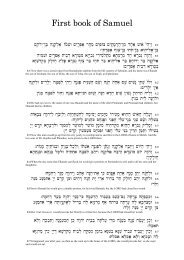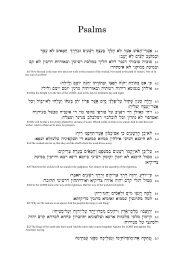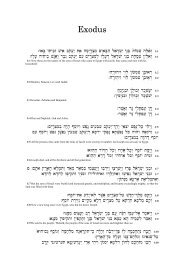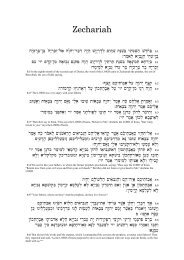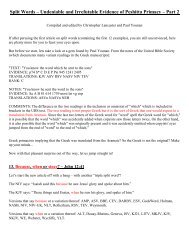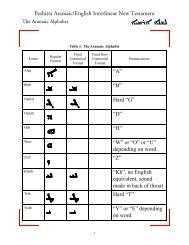ana translation
Untitled - Peshitta Aramaic/English Interlinear New Testament
Untitled - Peshitta Aramaic/English Interlinear New Testament
- No tags were found...
You also want an ePaper? Increase the reach of your titles
YUMPU automatically turns print PDFs into web optimized ePapers that Google loves.
x<br />
INTRODUCTION<br />
scholars who more than sixteen hundred years ago laid the foundation of<br />
all critical knowledge of the Septuagint. The lifelong labour of Origeii<br />
in constructing his immense Hexapla gave an impulse which, even<br />
after the actual volumes which contained his work had perished,<br />
remained in the Church as a living power. It quickened the zeal of<br />
Parnphilus, who in prison spent the hours of awaiting martyrdom in<br />
transcribing, and with the help of Eusebius collating, copies of the<br />
Septuagintal column of that master-work, enriched with a marginal<br />
apparatus of readings gathered from the other columns.* Through these<br />
men in turn that same impulse, transmitted by the medium of their<br />
autograph transcripts still accessible after three centuries, moved Paul,<br />
Monophysite Bishop of Telia, f to reproduce in Syriac the whole of the<br />
Septuagintal Old Testament as thus arranged and annotated. This<br />
great task was executed by him at Alexandria, where he spent some<br />
years (apparently a fugitive from troubles in his own country) in the<br />
second decade of the seventh century.^ And it is a notable fact that<br />
in this, its Syriac reproduction, the result of Origen's vast labour and<br />
learning has reached us in a state nearer to completeness than in the<br />
original Greek in the form into which it was cast by the pious diligence<br />
of Pamphilus and Eusebius. It "forms our chief authority for the<br />
text of Origen's revision. "<br />
*<br />
Some of these copies are even now represented for us by transcripts more or<br />
less partial or incomplete, of which the most notable are Cod. Golberto-Sarravianus<br />
(M) of the Octateuch, and Cod. Marchalianus (Q) of the Prophets, both of which<br />
are now accessible in photographic reproductions. See for these, Dr. Swete's<br />
Introduction to the O.T. in Greek, Part i, ch. v (pp. 137, 144 also ; pp. 148 et sqq.)<br />
t A city of Mesopotamia, distinguished as Tella-Mauzlat.<br />
J The work of Paul on the LXX, like that of his fellow-worker Thomas on the<br />
N.T., was obviously undertaken with a view of bringing the Bible of Syriac-speaking<br />
Christians into conformity with that of their Greek-speaking brethren in the faith,<br />
especially those of Alexandria the Monophysite Churches of Mesopotamia and of<br />
Egypt being in close communion. Both these men carried out their task in "the<br />
Enaton of Alexandria," in the same Antonine convent, at the same time (between<br />
A.D. 613 and 619) ;<br />
both had access there to the same storehouses of Biblical literature.<br />
These facts are gathered from the notes subjoined by Paul and Thomas to<br />
their versions (see the article Paulus Telknsis, D.C.B. vol. iv, p. 266 et sqq.). Their<br />
versions are executed in the same spirit of literal conformity to the Greek, without<br />
regard to the genius of the Syriac tongue. Both together were apparently meant<br />
to be taken as one Revised Syriac Bible. There is reason to believe that Thomas<br />
was one of those who helped Paul in his work (see p. 72 infr., notef on<br />
2 Chron. xxxiii. 3).<br />
Dr. Swete, in Introduction (as in note * above), p. 114.



